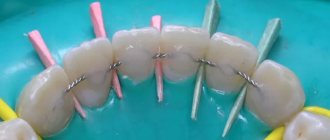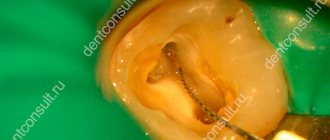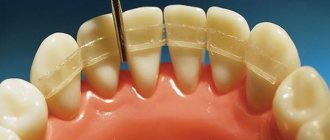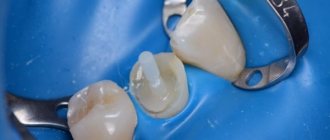The main task of a dental surgeon during the treatment of a fracture of the upper or lower jaw is to restore the anatomical structure of the broken bone and the correct relationship of the dentition. Many techniques help to achieve this, but the effectiveness of treatment also depends on how correctly and quickly first aid was provided.
Before hospitalization
First aid to the victim includes:
- stopping bleeding (pressing or packing the wound, applying cold);
- if necessary, cardiopulmonary resuscitation;
- pain relief (analgin, revalgin intramuscularly);
- immobilization of the jaw with the help of fixing bandages (contraindicated if the victim is unconscious, since this increases the risk of suffocation from the retraction of the tongue or vomit entering the respiratory tract).
Osteosynthesis
Indispensable for complex, comminuted and multiple fractures with displacement, loose teeth and complete absence of teeth, for periodontal disease and other inflammatory diseases of the gums in the area of injury. Osteosynthesis is also effective in cases of fracture of the condylar process complicated by dislocation of the articular head of the lower jaw.
Fastening materials can be steel knitting needles and rods, pins, nitride-tinan wire with shape memory, quick-hardening plastics, polyamide thread, special glue.
However, osteosynthesis with metal miniplates is considered the most convenient and safe method today. They allow you to cut through the skin and muscles on only one side, which simplifies the operation itself and shortens the recovery period. Another undeniable advantage is the ability to reliably fix fragments in areas with significant dynamic loads.
How to apply a splint for a jaw fracture
The procedure is performed under local anesthesia.
Splints for a fracture of the lower jaw, as well as for a fracture of the upper jaw, can be applied in different ways. There are several methods, each of which is selected depending on the nature of the damage.
- One-sided. It is used when one of the halves of the jaw bone is damaged. A copper wire is attached to the neck of the teeth.
- Two-way. It is used when the damage is more serious and it is necessary to secure the jaw in a fixed position on both sides at once. A rigid wire with rings and hooks is used, which increase the reliability of fixation.
- Double-jaw fixation, as the name implies, is used in the most severe cases, including when the fragments are damaged. This requires the most rigid splinting system - a copper wire structure is fixed to healthy teeth or to the alveolar bone, and then both jaws are connected using rubber rings with hooks.
It is worth knowing that an open fracture is characterized not only by damage to the soft and mucous tissues in the oral cavity, but also by a fracture or dislocation of the tooth root. Splinting teeth for a jaw fracture is very effective, but there are a number of cases when teeth have to be removed.
Removal is necessary or recommended:
- If the fracture involved a wisdom tooth.
- If the damaged tooth is very loose
- If the fracture passes between the roots of a multi-rooted tooth
- If a tooth is damaged and has inflammatory processes (radicular cyst or granuloma)
- If it is impossible to fix and correctly position fragments of a broken jaw without removing a tooth
- If the tooth has been severely damaged and restoration is impossible
- If the fracture contributed to tooth dislocation
- If the tooth is impacted
Method of laying copper wire before installing the busbar
But if there is a chance of recovery, then it is worth knowing that splinting teeth for a fracture of the lower jaw is as common as for a fracture of the upper jaw. Jaw shunting during a fracture is a method that allows you to fix the dentofacial row into one “monolith”, eliminating their mobility. When an injury occurs, teeth are sometimes displaced from the alveolar socket - this disrupts the adhesion of the bone to the tissue. The use of a non-removable splint in such cases is a direct indication. Splints allow you to fix loose teeth and prevent them from moving in different directions.
Jaw shunting for fracture
The materials used to make tires are quite varied. These include plastic, fiberglass, special rubber, and metal. Perhaps every experienced doctor has his own individual set of favorite materials with which he achieves the best results. At the same time, one should not forget about the individuality of each case. Materials are usually selected based on the patient's injury. Thus, what is suitable for one person may not be suitable for another. These questions should be addressed by the attending physician.
Splinting the jaw
This is the immobilization (fixation) of bone fragments using a special plastic or wire structure.
The technique, created by military doctors at the beginning of the 20th century, is successfully used by dentists today. The materials used to make the splint have changed, and the methods of applying it have been improved.
Today, a specialist has many types of tires in his arsenal:
- from standard Vasiliev tape splints, the simplest and cheapest method of treatment;
- to aluminum Tigerschdedt splints, which are made individually for each patient, due to which they are more effective. In addition, they evenly distribute the load and minimally injure the teeth.
The type of splinting depends on the type of injury and can be unilateral (when one jaw is fractured) or bilateral (when both are damaged).
If the teeth are preserved, it is not difficult to apply a bent dental wire splint. It is bent to the shape of the dental arch and fixed with bronze-aluminum wire ligatures, which, like a hairpin, cover the tooth on both sides. Manipulations are performed under local anesthesia.
When both jaws are fractured, a structure with a more rigid base is installed; in addition to wire, hooks and rings are also used that immobilize the lower jaw.
Material for splinting teeth
Several types of materials are used for splinting teeth, the choice of which depends on the characteristics of a particular clinical case. The main ones are fiberglass, aramid threads, metal and ceramics. When it comes to retainers, removable silicone mouth guards can be used. Composite dental splinting materials are used to secure the splint. Separate splinting of teeth with composites is not carried out.
Fiberglass
Adhesive fiberglass tape is used as a splint. Splinting teeth with fiberglass tape offers a number of benefits. This is an aesthetic and hypoallergenic material that has the necessary strength for reliable fixation. The service life of fiberglass tape for splinting teeth is 3-4 years. Therefore, it is not suitable for long-term use. The average cost of splinting teeth with fiberglass ranges from 3,500 to 8,000 rubles, depending on the area of the jaw and the number of teeth.
Cable-stayed
An aramid thread is used, which is several times stronger than steel. It is much more durable than fiberglass, safe for fabrics and resistant to the external environment. It is not recommended to splint the front teeth with aramid, since the material has a rather noticeable yellowish tint. The cost of cable-stayed splinting of teeth with floss starts from 2000 rubles per tooth.
Byugelnoye
Splinting teeth with clasp dentures allows you to solve two problems at once - fixing mobile teeth and restoring lost units. The clasp prosthesis has a metal frame and a soft base. Attached to abutment teeth using clasps or micro-locks. Bugel splinting of teeth will cost approximately 35,000 rubles and more.
Retainers
This type does not belong to classic splinting. The primary goal of retainers is to prevent teeth from shifting back into the wrong position after braces are removed. Fixed retainers are usually made of metal or fiberglass and are essentially no different from a regular splint. Removable retainers can be in the form of trays or plates. You need to wear retainers for a long time (at least 5-6 years after removing braces), and sometimes for life. Cost: from 3,000 to 10,000 rubles per jaw, depending on the system.
Splinting for jaw fractures
In case of jaw fractures, it is necessary to fasten the damaged areas of the bone and prevent the teeth from moving. The result is a rather bulky structure made of wire, hooks and silicone loops. The cost of the procedure can reach up to 20,000 rubles and depends on the complexity of the fracture.
Crowns
Installation of a fixed denture is also one of the types of splinting, since it allows you to ensure the stability of a section of the dentition with the help of artificial crowns. Splinting of 1 tooth is carried out using the single prosthetic method. To splint 2 or more teeth, a bridge is most often placed. The cost of single prosthetics starts from 8,000 rubles, multiple - from 30,000 rubles. This is the minimum price for metal ceramics; a prosthesis made from more modern materials will cost much more.
Is it possible to do without splinting?
Even if the case is not severe - the fracture is one-sided, closed and without displacement - it is imperative to take measures to prevent the development of such unpleasant complications as:
- accidental displacement of fragments,
- re-injury
- development of inflammation of soft tissues,
- infection of the fracture site.
To do this, it is necessary to immobilize the jaw by any available method. This can be a sling bandage, but it is much more convenient and effective to use a splint. In case of a complicated fracture, splinting is absolutely indispensable, regardless of the location of the injury.
Removable tires
When splinting, removable and non-removable splints are used. Each type has individual indications for installation and its own advantages.
Removable splints are special plates and mouth guards. With their help, it is possible to connect a certain number of teeth even if some teeth are missing. The result is a restored dentition.
The removable method is always used after mechanical damage, such as severe bruise and fracture. In this case, the treatment will fix the dentition in the correct position and prevent any change in this position.
Metal or plastic is always used to make removable tires.
Advantages of removable splinting:
- No pulp removal is required.
- There is no need to grind the surface of the teeth.
Splinting systems
- Elbrecht system. It contains clasps that are installed on the front teeth. Fixes the entire dentition very well. Typically used for first degree mobility and absence of periodontal and periodontal disease.
- One-piece mouth guard system. This is the Elbrecht system with some modification. With its help it is possible to fix the front teeth (canines, incisors). The attachment is based on protective caps that effectively protect the dental arch from uneven, increased chewing load.
- Circular tire. It has two varieties: the first is regular, the second is with claw processes. This system is very effective for severe mobility. A circular splint should not be used when teeth deviate from their axis.
Treatment tactics for displaced fractures
In such cases, before applying a splint, it is necessary to compare the jaw fragments, for which reduction orthopedic devices are used. A broken upper jaw requires traction using special dental splints.
Such injuries are very dangerous because they can cause asphyxia. But correctly provided first aid will prevent suffocation. Clear the oral cavity of foreign bodies or blood, lay the victim face down, placing a cushion rolled up from clothes, blankets, etc. up to the chest.
Features of the splinting procedure
In dentistry, there are many types of diseases that can potentially increase tooth mobility. This causes severe discomfort and negatively affects the condition of the jaw apparatus. It becomes difficult for a person to chew and he has to adhere to a special diet.
To solve this problem, you need to use a splinting technique. At its core, this is a procedure for strengthening teeth, which allows you to connect several units in a row and protect them from falling out.
The application of a splint is necessary so that there is not such a strong load on the gums, and other treatment methods can be freely applied. At the same time, it will be much more comfortable for the patient to chew different types of food.
Unloading tissue with splinting helps reduce the intensity of the inflammatory process. This is especially useful for periodontitis, when it is necessary to keep the gums in a calm state while doctors carry out general sanitation and restore damaged teeth.
In this material we will tell you in more detail how teeth splinting is done, what products are used in the process, and also touch on many other important issues regarding the procedure.
Rehabilitation after a jaw fracture
For successful treatment of a jaw fracture, anti-inflammatory and restorative therapy, physiotherapy, mechanotherapy and special oral hygiene are also important.
- Within 3-4 days after the injury, antibiotics must be prescribed to prevent inflammation, which are injected directly into the area of injury.
- General strengthening therapy is taking vitamins C, P, D and group B, drugs that stimulate tissue regeneration and restore the level of leukocytes in the blood.
- Among the effective physical procedures, we note UHF therapy, general ultraviolet irradiation, and magnetic therapy. After the third procedure, swelling and pain are noticeably reduced, swelling subsides. For better healing of fragments, 2 weeks after a jaw fracture, electrophoresis is performed using a two to five percent solution of calcium chloride.
- Mechanotherapy, or physical therapy, accelerates the restoration of jaw function and helps if, after an injury, the mouth opens poorly or does not open at all. It can also be practiced at home, starting 4-5 weeks after the fracture, when the splints are removed and a callus has formed.
- Special hygiene involves irrigation at least 8-10 times a day. For unconscious victims, their teeth and mucous membranes are treated with a special solution at least twice a day.
Indications and contraindications for splinting
This procedure is used in the following cases:
- Dental defects, tooth shifts.
- Incorrect position of teeth.
- Restoration of teeth after braces.
- Damage to soft tissues and bleeding gums.
- Exposed roots and pronounced gum pockets.
- The presence of dental plaque, which very quickly accumulates near the root of the tooth.
A dentist can prescribe a splinting procedure after an examination and x-ray of the oral cavity.
Splinting is contraindicated in the following cases:
- Periodontal inflammation.
- With primary periodontal trauma.
- The chewing surface of the teeth has not yet been corrected by partial grinding.
- Lack of quality oral hygiene.
How to eat?
Since during intensive therapy and during the recovery period the jaws are rigidly fixed and habitual chewing of food is out of the question, correction of the diet is necessary during this period.
Food should have the consistency of low-fat sour cream. These are broths, pureed soups, carefully chopped vegetables and fruits, milk drinks, liquid cereals. Spices are excluded, salt consumption is limited. The temperature of the dish should not be higher than 45-50 °C. The most convenient way to eat food is through a straw.
You need to gradually switch to your usual diet after removing the splint. This is important not only for restoring chewing functions, but also for preventing disorders in the gastrointestinal tract.
How much does it cost to treat a broken jaw?
The price depends on the nature of the injury, whether osteosynthesis was performed, what splints were used, and whether the patient attended physical therapy procedures. But let's say for sure that the service is not cheap. Osteosynthesis alone will cost from 14,000 to 55,000 rubles.
It is also necessary to consider the cost of subsequent dental treatment to restore lost teeth or damaged teeth after splinting. Our service will help you choose a competent specialist and not waste your money. Compare prices and services of different clinics, read reviews from real patients.











